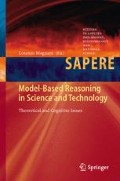Abstract
For the Arabs in the beginning was the sound and the letter. Only afterward, the written word embodied and conditioned by the Qur’an. The phonetic and graphic shapes of the letters inspired a series of analogies which related to God as universal wholeness and script. Basing themselves on the close observation of the Qur’anic script as absolute matrix the Arab scholars began to model it constructing formal theories to describe and explain its meanings and their applicability in everyday life. Thus, the Qur’anic written text and the geometrical forms derived from it extended to all aspects of real life subliminally placing man into an iconic world of letters which intermediate between theories, applications and their absolute model.
Access this chapter
Tax calculation will be finalised at checkout
Purchases are for personal use only
Notes
- 1.
The Qur'an 85:22.
- 2.
In Arabic, graphic sign shaped as a small circle denoting the absence of a vowel.
- 3.
Al-Qur'an, 43:4, 85:21–22.
- 4.
That's why the Qur'an is known as well under the name of al-furqān (“what distinguishes truth from untruth”).
- 5.
Term apparently derived from the 2nd form root fassara, meaning “to open” or “to expose”.
- 6.
This method is also known as ta’wīl, literally meaning the “return of the meaning to its original matrix”.
References
Orgill, M.K., Bodner, G.M.: An analysis of the effectiveness of analogy use in college-level biochemistry textbooks. J. Res.Sci. Teach. 43(10), 1040–1060 (2006)
Curtis, R.V., Reigeluth, C.M.: The use of analogies in written text. Instr. Sci. 13, 99–117 (1984)
Gentner, D.: Structure mapping. A theoretical framework for analogy. Cogn. Sci. 7(2), 155–170 (1983)
Holyoak, K.J., Thagard, P.: The analogical mind. Am. Psychol. 52(1), 35–44 (1997)
Pomorska, K., Rudy, S., Jakobson, R.: Language in Literature, p. 419. Harvard University Press, Cambridge (1987)
Bufano, A.: Autoipnosi e terapia, Vertici Network di Psicologia e Scienze Affini, http://www.vertici.com
Grohman, A.: Arabische Paläographie. Wien, Böhlau in Commission, p. 11 (1971)
Healey, J.F.: The Early Alphabet, p. 54. University of California Press, Berkeley (1990)
Abulhab, S.D.: DeArabizing Arabia. Tracing Western Scholarship on the History of the Arabs and Arabic Language and Script, pp. 233–235. Blautopf Publishing, NY-Ulm (2011)
Holes, C.: Modern Arabic. Structures, Functions and Varieties. pp. 99–100. Georgetown University Press, Georgetown (2004)
Nasr, S.H.: Islamic Art & Spirituality. p. 32. Golgonooza Press, Ipswich (1990)
’Ibn ‘Aṭā’ ’ Allah: Traité sur le nom ’ Allah, (introduction, traduction et notes par Maurice Gloton), pp. 137–138. Les Deux Océans, Paris (2001)
Massignon, L.: Essai sur les origines du lexique technique de la mystique musulmane.In: Vrin, J. (ed.), p. 38. Paris (1954)
Yousef, M.H.: Ibn Arabi—Time and Cosmology, p. 155. Routledge, New York (2008)
Al-Jīlī, A.K.: Al-kahf wa ar-raqīm fī sharh bi’smi-llah-i-rrahman ar-rahīm. p. 20. Dar al-Kutub al-‘Ilmiyah, Bayrut (2004)
Lings, M.: A Sufi saint of the twentieth century: Shaikh Ahmad Al-‘Alāwī, his spiritual heritage and legacy. p. 153. University of California Press, Berkeley (1971)
Vitray-Meyerovitch, E. de: Mystique et Poésie en Islam, p. 171. Desclée de Brouwer, Paris (1982)
Derman, M.U.: The art of calligraphy in Islam. In: Ihsanoglu, E. (ed.) The Different Aspects of Islamic Culture, Culture and Learning in Islam, vol. 5, p. 570. UNESCO Publishing, Paris (2003)
Khatibi, A.: La blessure du nom propre. Denoel, Paris (1974)
Ibn Khaldūn: The Maqaddimah: An Introduction to History. (translation by Franz Rosenthal). vol. 1, Pantheon Books, New York (1958)
Ahmed, H.: Introducing the Quran: How to Study and Understand the Quran, p. 170. Goodword Books, New Delhi (2004)
White, B.Y., Shimoda, T.A., Frederiksen, J.R.: Enabling students to construct theories of collaborative inquiry and reflective learning: computer support for metacognitive development. Int. J. Artif. Intell. Educ. 10, 151–182 (1999)
Author information
Authors and Affiliations
Corresponding author
Editor information
Editors and Affiliations
Rights and permissions
Copyright information
© 2014 Springer-Verlag Berlin Heidelberg
About this paper
Cite this paper
Tamas, C. (2014). The Arabic Script, from Visual Analogy to Model-Based Reasoning. In: Magnani, L. (eds) Model-Based Reasoning in Science and Technology. Studies in Applied Philosophy, Epistemology and Rational Ethics, vol 8. Springer, Berlin, Heidelberg. https://doi.org/10.1007/978-3-642-37428-9_8
Download citation
DOI: https://doi.org/10.1007/978-3-642-37428-9_8
Published:
Publisher Name: Springer, Berlin, Heidelberg
Print ISBN: 978-3-642-37427-2
Online ISBN: 978-3-642-37428-9
eBook Packages: Humanities, Social Sciences and LawPhilosophy and Religion (R0)

